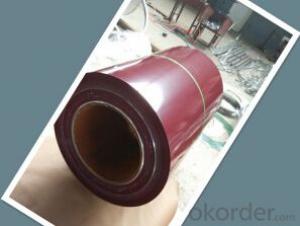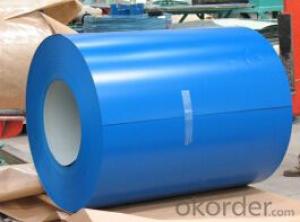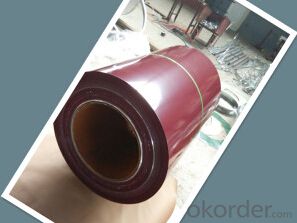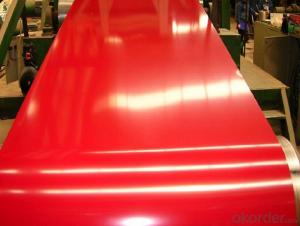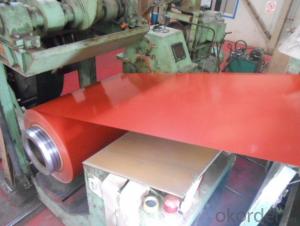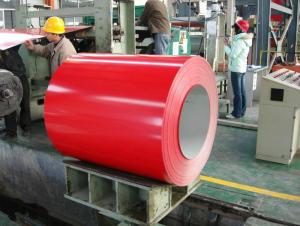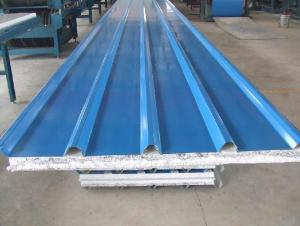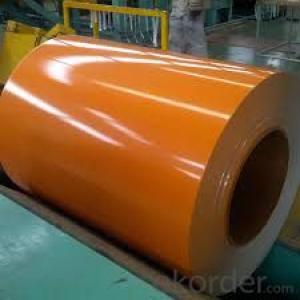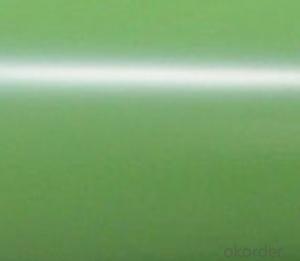Prepainted Steel Coils with Plain or Matt Surface
- Loading Port:
- Tianjin
- Payment Terms:
- TT OR LC
- Min Order Qty:
- 25 m.t.
- Supply Capability:
- 10000 m.t./month
OKorder Service Pledge
OKorder Financial Service
You Might Also Like
Prepainted Steel Coils description:
Model NO.:0.5*1000*C
Surface Treatment:Coated
Certification:ISO, SGS, BV, SGS & ISO9001:2008
Technique:Cold Rolled
Standard:ASTM, JIS, GB, AISI, DIN, BS
Application:Sandwich Panels, Corrugated Steel Sheets
Edge:Slit edge
Stock:Not Stock
Steel Grade:CGCC & Cglcc
Thickness:0.16~1.20mm
Color:Ral Color
Coil Width:600~1250mm
Coil ID:508/610 Mm
Export Markets:Global
Additional Info.
Trademark:HZZN
Packing:Seaworthy, Standard Export Package, in Container
Standard:0.50*1000*C
Origin:China
HS Code:7210701000
1) Standard: JIS G3312 CGCC & CGLCC, equivalent to ASTM A755M, EN10169
2) Grade: CGCC and CGLCC
3) Hardness: Both soft and full hard are available
4) Surface finish: With or without protect film covered
5) Thickness range: 0.16-1.20mm
6) Coil width: 600-1250mm, general 914mm, 1000mm, 1220mm and 1250mm.
7) Shape: Both sheet and coil are available
8) Coating: Z40 to Z275, or AZ30 to AZ150
9) Paint thickness: Top 5 um + (10-20) um polyester, Reverse 5-10 um Epoxy
10) Color: any RAL code, or according to customer's sample
11) Coil weight: 3-6 tons, or according to customer's requirements
12) Max loading in one 20ft container: 25 tons generally
13) MOQ: 25 tons for each thickness or color;
14) Delivery time: 2 weeks or one month generally.
15) Applications: Widely used for roof tiles, outer walls, ovens, explosive-proof steel, electrically controlled cabinets, and industrial freezers in the residential and industrial buildings
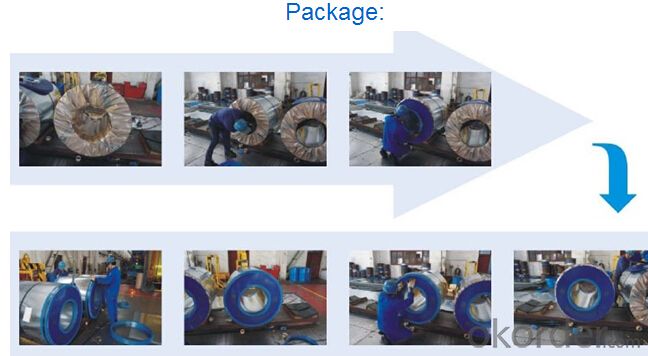
specification:
| Prepainted galvanized steel coil ( PPGI ) | Prepainted galvalume steel coil ( PPGL ) | |
| Standard | JIS G3312 CGCC ASTM A755M EN10169 | J IS G3322 CGLCC AS 1397 G2+AZ |
| Valid thickness | 0. 16 ~1. 2 0mm | 0. 16 ~1. 2 0mm |
| Coil width | 600~1250mm | 600~1250mm |
| Coil ID | 508mm & 610mm | 508mm & 610mm |
| Coil weight | 3~5 tons | 3~5 tons |
| Coating | 4 0~275 g/m2 | AZ30 to AZ150 |
| Paint t hickness , top side | 15~25 microns | 15~25 microns |
| P aint t hickness , reverse | 5~7 microns or 15~25 microns | 5~7 microns or 15~25 microns |
| Color | any RAL code | any RAL code |
| Package | vertical, eye to sky & horizontal | vertical, eye to sky & horizontal |
| MOQ | 25 tons | 25 tons |
- Q: How are steel coils used in the production of metal fixtures?
- Steel coils are an essential component in the production of metal fixtures. These coils, which are typically made from carbon steel, are used as the primary raw material to manufacture a wide range of metal fixtures. The steel coils are first uncoiled and then cut into sheets of the desired size and thickness. These sheets serve as the base material for different types of metal fixtures, including brackets, hinges, handles, and other structural components. Once the sheets are cut, they undergo various forming processes such as bending, stamping, or rolling. These processes help shape the steel sheets into the specific design required for the metal fixture. For instance, bending may be used to create brackets or angles, while stamping can be used to form intricate patterns or shapes. After the forming processes, the steel sheets are often subjected to welding or joining techniques to assemble multiple components of the metal fixture. Welding ensures that the various parts are securely attached, providing strength and durability to the final product. Furthermore, steel coils also play a crucial role in enhancing the appearance and longevity of metal fixtures. They can be coated or treated with protective layers, such as galvanized or powder coatings, to prevent corrosion and provide a polished finish. These coatings ensure that the metal fixtures can withstand environmental factors and extend their lifespan. In summary, steel coils are an integral part of the production process for metal fixtures. They are transformed into sheets, which are then shaped, joined, and coated to create a wide range of functional and aesthetically pleasing metal fixtures used in various industries.
- Q: What are the different methods of tempering steel coils?
- There are several different methods of tempering steel coils, each with its own advantages and disadvantages. Some of the most common methods include: 1. Air cooling: This is the simplest and most common method of tempering steel coils. The coils are heated to a specific temperature and then allowed to cool naturally in ambient air. This method is relatively quick and cost-effective, but it can result in uneven cooling and may not provide as precise control over the final properties of the steel. 2. Water quenching: In this method, the steel coils are heated and then rapidly cooled by immersing them in a bath of water. Water quenching provides a more rapid and controlled cooling rate than air cooling, resulting in greater hardness and strength. However, it can also lead to increased distortion and the formation of internal stresses in the steel. 3. Oil quenching: Similar to water quenching, oil quenching involves immersing the steel coils in a bath of oil to rapidly cool them. Oil quenching provides a slower and more uniform cooling rate compared to water quenching, resulting in reduced distortion and internal stresses. However, it also produces slightly lower hardness and strength compared to water quenching. 4. Salt bath quenching: This method involves immersing the steel coils in a heated bath of molten salt to rapidly cool them. Salt bath quenching provides an even and controlled cooling rate, resulting in improved hardness and strength compared to air or water quenching. However, it requires specialized equipment and may not be suitable for all types of steel. 5. Induction hardening: In this method, the steel coils are heated using an induction heating process and then rapidly cooled using either air, water, or oil quenching. Induction hardening allows for precise control over the heating and cooling process, resulting in specific hardness and strength properties in desired areas of the steel. However, it requires specialized equipment and is typically used for specific applications or parts of the steel coils. Overall, the choice of tempering method depends on various factors such as the desired properties of the steel coils, the type of steel being used, and the specific requirements of the end application.
- Q: What are the different methods of coil welding for steel coils?
- Steel coils can be welded using various methods, each with its own pros and cons. The following are some commonly used techniques: 1. Resistance Welding: In this method, an electric current is passed through the coils to generate heat, which fuses the ends together. It is a fast and efficient process that produces reliable welds. Industries requiring high-speed production often utilize resistance welding. 2. Arc Welding: This technique involves creating an electric arc between an electrode and the workpiece to create a weld. It can be further categorized into processes like shielded metal arc welding (SMAW), gas metal arc welding (GMAW), and flux-cored arc welding (FCAW). Arc welding offers good penetration and can be applied to a wide range of steel coils. 3. Laser Welding: Laser welding employs a high-powered laser beam to melt and join the ends of the coils. It provides precise control, high welding speeds, and minimal distortion. Industries such as automotive and electronics, which require precision and aesthetics, often rely on laser welding. 4. Induction Welding: This method involves using electromagnetic induction to heat the coils, which then melt and are pressed together to form a weld. It is suitable for thin-gauge steel coils and allows for precise control over the welding process. 5. High-Frequency Welding: High-frequency current is used to heat and weld the coils together in this technique. It is commonly used for pipes and tubes and offers high production rates and good weld quality. 6. Friction Welding: Friction welding creates a weld by generating heat through the rubbing of the coil ends. It is a fast and reliable method that produces strong joints. Industries requiring high-strength welds, such as automotive and aerospace, often employ friction welding. These are just a few of the many coil welding methods for steel coils. The choice of technique depends on factors like the steel type and thickness, required weld strength, production speed, and project requirements as a whole.
- Q: my step father bought a big steel drum grill it has steel sheets (very thin) that go inbetween the flame and the food (closer to the flame) with that there the food will not cook, it does not get hot enough????? please help... what should we do
- You said Big steel drum. When you cook on this big steel drum are you cooking little amounts of food? This may be why you cannot cook it right. If you are using it correctly the barrel should be filled with right amount of charcoal so it heats up to its capacity. Also keep the lid closed when cooking it keeps the heat in.
- Q: How are steel coils used in the manufacturing of food packaging?
- Steel coils are commonly used in the manufacturing of food packaging as they are shaped and formed into cans, containers, and lids, providing a strong and durable material for ensuring the safety and preservation of food products.
- Q: How are steel coils used in the manufacturing of automotive frames?
- Steel coils are used in the manufacturing of automotive frames by being processed into flat sheets, which are then cut and formed into the desired shape and size to create the frame components. These components are then welded together to form the strong and durable structure of the automotive frame.
- Q: What is the maximum diameter of a steel coil?
- The maximum diameter of a steel coil can vary depending on the specific manufacturing process and equipment used. However, in general, the maximum diameter of a steel coil can range from a few inches to several feet.
- Q: What are the common coil thickness tolerances?
- The common coil thickness tolerances can vary depending on the specific industry and application. However, in general, common coil thickness tolerances range from +/- 0.001 to +/- 0.010 inches.
- Q: How are steel coils used in the agricultural sector?
- Various purposes in the agricultural sector call for the widespread use of steel coils. One primary utilization is seen in the construction of farm machinery and equipment. Tractors, plows, harvesters, and other heavy-duty machinery are frequently manufactured using steel coils. The exceptional strength and durability of steel make it an ideal material for such applications, as it can endure the challenging conditions of agricultural work. Furthermore, agricultural buildings and structures heavily rely on steel coils in their construction. Steel is renowned for its superior structural integrity, making it a popular choice for barns, storage units, and other agricultural facilities. Steel coils are frequently employed to establish the framework and support systems of these structures, providing stability and long-lasting durability. Moreover, irrigation systems also rely on steel coils in their production. Steel coils are often used to create the pipes and tubes used for water transportation in agricultural irrigation systems. Steel's resistance to corrosion and its ability to handle high-pressure flows make it an excellent choice for this particular application. To summarize, steel coils hold a critical role in the agricultural sector. Whether it be the construction of farm machinery and buildings or the development of irrigation systems, steel's strength and durability make it the preferred material in this industry.
- Q: What are the main raw materials used in making steel coils?
- The main raw materials used in making steel coils are iron ore, coal, and limestone.
Send your message to us
Prepainted Steel Coils with Plain or Matt Surface
- Loading Port:
- Tianjin
- Payment Terms:
- TT OR LC
- Min Order Qty:
- 25 m.t.
- Supply Capability:
- 10000 m.t./month
OKorder Service Pledge
OKorder Financial Service
Similar products
Hot products
Hot Searches
Related keywords
